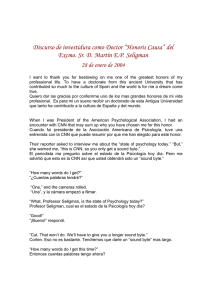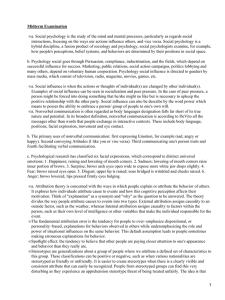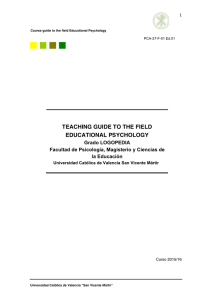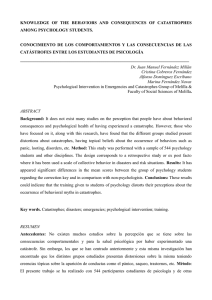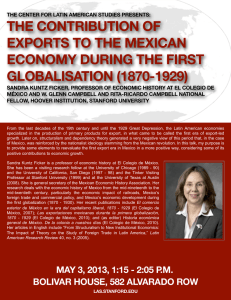Community Psychology and Social Problems in Mexico Eduardo
Anuncio
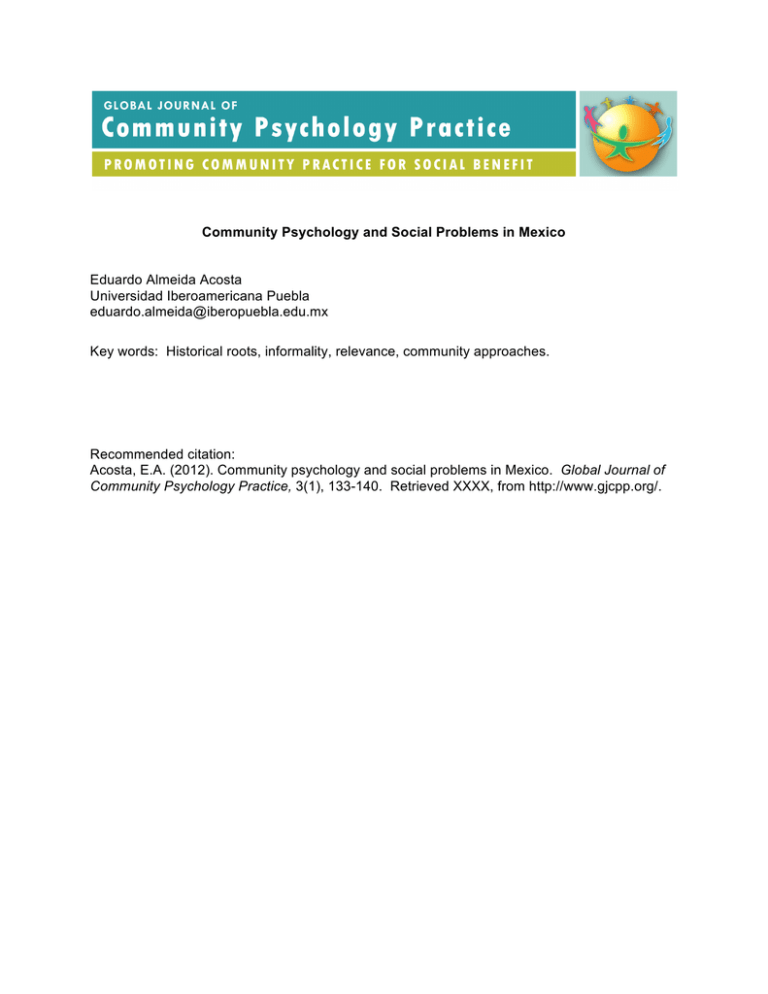
Community Psychology and Social Problems in Mexico Eduardo Almeida Acosta Universidad Iberoamericana Puebla [email protected] Key words: Historical roots, informality, relevance, community approaches. Recommended citation: Acosta, E.A. (2012). Community psychology and social problems in Mexico. Global Journal of Community Psychology Practice, 3(1), 133-140. Retrieved XXXX, from http://www.gjcpp.org/. Volume 3, Issue 1 Global Journal of Community Psychology Practice March 2012 Community Psychology and Social Problems in Mexico. Abstract Community Psychology has basically been an informal academic field of studies and practices. Its roots can be traced to an implicit community psychology practiced by indigenous and rural populations since pre-hispanic times, through colonial rule, XIX century republican regimes, post Mexican Revolution rural education programs and governmental and non governmental community development initiatives. The actual academic field of Community Psychology in Mexico shows a scarcity of academic programs that have not had the opportunity to become firmly established in higher education institutions. The main sources of academic theory and practice in contemporary Community Psychology in the world have had limited influence in Mexico. American community psychology with its strong clinical trend has been present but has not been the most important source of impact on Mexican community psychologists. Latin American community psychology with its contributions to confront the irrelevance of social psychology has also contributed to the development of Mexican community psychology but its influence was not decisive and only recently fruitful exchanges have been established. The field in Mexico has been informally evolving through the practices and thinking of Mexican psychologists confronted by pressing social challenges they have been forced to face in their efforts to make psychology relevant and useful. Mexican psychoanalysts tried to apply their expertise with marginalized urban settings. Humanist psychologists looked for underserved populations to make explicit their professional commitment in serving humanity. Behavior psychologists tried to devise a training curriculum centered on community service. Clinical psychologists at UNAM were concerned about the problems of our people in the big metropolis and by the traumas caused by natural disasters. Psychologists from all over Mexico and from diverse academic subfields and traditions have been working hand in hand with anthropologists, sociologists, social workers, popular educators, rural experts, and all sort of fields of study, in confronting the problems generated by the unequal distribution of wealth, corruption, the literacy and digital gaps, the denial and discrimination of ethnic peoples, and the increasing violence endured by many people in different regions of the country. What will be the future of community psychology in Mexico? What have we learned? What are our weaknesses and what are our strengths? Do we need a more formal training? Do we need a formal employment market? Do we have something specific to offer among the health, education and social sciences? What are our theoretical and practical inputs? We live in difficult times. Community Psychology will be more needed than ever. What should we do to make it relevant? Introduction Community Psychology, an innovative field of psychology worldwide, has special characteristics in Mexico. As an academic field it is made up of rather informal studies and practices in the sense that they are not primarily related to teaching tasks and obtaining degrees. In Mexico, however, it has strong implicit roots that date back to pre-Hispanic times in which, for example, in the Aztec empire on the one hand there was the state with the emperor and his politicallymotivated cultural practices that we have all heard about such as the ceremonies in large temples and the historical accounts that have reached us. Along with this there was the reality of the communities where the populations' daily life took place (Soustelle, 1983: 25), a reality that we have less knowledge of than of the political practices at a more general level. During the colonial period and in the face of the control practices that were exerted on indigenous people by the conquerors, community life continued to be a fact of life that allowed these populations to survive in the midst of situations of exploitation, oppression, contempt and discrimination ( Reyes Garza, 2000: 75). Following the Independence and despite the attempt to create a republican nation imitating the French and American liberal proposal, the typical features of rural and indigenous life continued because important Global Journal for Community Psychology Practice, http://www.gjcpp.org/ 134 Volume 3, Issue 1 Global Journal of Community Psychology Practice March 2012 practices and experiences of community life remained (Escalante Gonzalbo, 1999: 59) .The attempt to make the indigenous people citizens, at the expense of ceasing to exist as such, failed. In the struggle for Independence indigenous people and peasants did the job for the creoles, without really benefiting from the processes of independence. All the effort to create a country of Mexican citizens tended to end the ethnic reality of indigenous groups (Acuña, 1981). In the battles of the Revolution, peasants and indians also developed the fundamental role. After a hundred years two realities remain: first, that they were the least benefited by the revolutionary movement, and second that they did not cease to exist as peasants and as indigenous peoples. The current reality is that the community life of these people is what has allowed them to survive (Bennholdt-Thompsen, 1998: 50) and what that allows them to envision a day when they can have access to a dignified life (Jiménez, 2007: 77). In short, what I will attempt to refer to is the existence, between peasants and indigenous people of Mexico and numerous semi-urban and even urban populations, of locations, love, values and their own powers for a genuine community life. Therefore we speak of an implicit community psychology (Almeida and Flores Osorio, 2011). Currently, at an academic level, there are only two universities in which to study a master's or doctorate in community psychology (Flores Mercado, 2009; Illescas, 2003).These are two programs that have faced many problems in attempting to prevail for several reasons, including the myth of the lack of job opportunities for those who are dedicated to studying this field. At an undergraduate level, there are courses or subjects in which community psychology is taught, and even at the UNAM it exists as a terminal field (Montero and Varas Díaz, 2007: 72).Aside from these academic realities, community psychology survives thanks to psychologists of all specialties who undertake community work (Almeida, Martinez and Varela, 1995). The contact of Mexican community psychology with community psychology worldwide has up to now been limited and marginal; this has been the result of how it has developed in response to needs in the face of social challenges. There was some influence of American community psychology in the seventies in the past century thanks to an academic program that was established at the Instituto Tecnologico y de Estudios Superiores de Occidente (ITESO) in Guadalajara. But very soon the program organizers realized that such oritentation as presented was not relevant to the communities in the area. Then they supplemented it with an approach toward humanistic psychology (Gómez del Campo, 1994). On the other hand, Latin American community psychology (Marín, 1988), which developed in the seventies and eighties due to the attempt to make relevant a social psychology that was devoted to the study of abstract entities and to the influence of social scientists as important as Paulo Freire and Orlando Fals Borda, was not a decisive influence on the beginnings of Mexican community psychology. Where does Community Psychology emerge from in Mexico? Mexican community psychology arises from the need to address social challenges by psychologists from different theoretical orientations. For example, orthodox psychoanalysts tried to apply their knowledge to meet urban marginality. Thus arose the program known as Psychocommunity (Cueli and Biro, 1975) which was developed by teachers and students from the UNAM and the Universidad Iberoamericana in Mexico City. The program is true social psychotherapy and is still relevant, albeit small, in various community experiences. As stated earlier, psychologists with a humanistic orientation such as Juan Lafarga and José Gómez del Campo used the approach of Carl Rogers to address urban populations (Lafarga and Gómez del Campo, 1992). At the National School of Professional Studies Iztacala (ENEP-Iztacala), behavioral psychologists developed the study plan for the major in Psychology in terms of practices closely tied to community service in its area of influence (Lozano Treviño and Lezama, 2003). UNAM clinical psychologists decided to complete the training of their students by connecting them with the searing realities of the marginalized urban environment (Valenzuela Cota, 1995). They also addressed the psychological problems of the university community, and played an important role in the response to psychological problems caused by disasters such as the earthquake that struck Mexico City in September 1985. Several social psychologists linked to the UNAM, to the Universidad Autónoma Metropolitana Iztapalapa campus, to the Autonomous University of Puebla and several other universities also began to develop a community psychology based on the theoretical positions they preferred such as the operational Global Journal for Community Psychology Practice, http://www.gjcpp.org/ 135 Volume 3, Issue 1 Global Journal of Community Psychology Practice March 2012 groups of Pichón Rivière, the aforementioned Psychocommunity and the Ecology of Human Development of Urie Bronfenbrenner (Bronfenbrenner, 1979). In all these approaches to community there were interdisciplinary relations with social anthropologists, social workers, popular educators, rural experts, feminist sociologists, etc. In all, the target was oriented toward facing the social challenges of unequal distribution of wealth, corruption, illiteracy, discrimination and violence. This set of circumstances and needs is what the basis of Mexican community psychology is and perhaps that's where their most interesting contributions emerge. What science are we talking about? Ever since the seventies and perhaps the sixties there was plenty of talk about the intellectual and practical crisis of social psychology. This is mentioned now, not only in relation to this branch of psychology, but it can be said of all social sciences (Bartra, 2009). In those years, sociology was a field of study which was highly sought by students. Today, few choose it, due in part to the difficulty involved in a life devoted to researching social problems, instead of dealing professionally with the problems it studies. The trends of capitalism after the fall of the Berlin Wall, neoliberalism and the scarcity of jobs in recent times have added to this intellectual crisis of Social Sciences. Moreover, according to several experts in these sciences, the crisis has also been caused by the isolation of its practitioners, the lack of a critical sense with regard to one's own work and approaches of these fields, to the lack of communication, the fragmentation of many schools of thought and the jumble of theoretical papers without empirical support (Bartra, 2009). In the face of this intellectual crisis, what can we say of a psychology which has been socially accused of being useless? Just as for other social sciences, in psychology there is also a shortage of critical studies of the science itself as well as isolation and fragmentation. The excessively individualistic approach to psychology, that we have ironically sometimes called that of attention to the middle-class' neurosis, has prevented us from being aware of the country in which it develops, a country where mental health problems are of a more collective nature and are related to cultural and structural causes (Almeida, 2011). This explains the reluctance of directors of many psychology schools and departments, throughout the territory, to make social psychology the orientation that corresponds to the needs of the country. Psychology is currently the human and social sciences major with the highest demand by students because it allows them to orient themselves toward the performance of a professional practice (Bartra, 2009) with little relevance in the social area. This explains the scarcely academic reality, in the curricular sense, of Community Psychology. What have the contributions of Community Psychology been? The origin of community psychology in Mexico can be found in the response to social challenges. This has allowed it to have a path without as much fragmentation as other branches of psychology or that of other social sciences. Educational psychologists, organizational psychologists, health psychologists, clinical psychologists and social psychologists have found themselves working side by side and face to face in trying to solve social problems in communities in which they have worked. The awareness of this non-fragmentation has not been assessed at its full potential. This is so because as in other social sciences there is a lack of criticality and assessment in its practitioners. If something is unusual in Community Psychology it is its proximity to society. Here one cannot apply the accusation of the remoteness of science toward the problem it intends to study. The proximity to society and the discretion of its actions however, have not allowed Community Psychology to become more visible in the perception that governments have had of its activity, even though many community psychologists work in government organizations or government programs. The designers of these programs and the bureaucrats, who control them, seldom realize the knowledge, skills and attitudes displayed by these community psychologists in undertaking their task in order to make the role they play be less of assistance. The work of community psychologists is seldom mentioned in the domesticated mass media which often takes on critical positions of resistance in the face of government aberrations. It is known that social sciences, particularly economics and political science, have focused on responding to issues of concern to the authoritarian governments that have characterized Mexico (Bartra, 2009). The work of Community Psychology on the other hand develops between alternative programs, with low visibility and low submission to the demands of the State. Global Journal for Community Psychology Practice, http://www.gjcpp.org/ 136 Volume 3, Issue 1 Global Journal of Community Psychology Practice March 2012 In academia, community psychology is presented as a marginal trend. Community psychologists have had to achieve recognition by the usefulness of their work and products that have been achieved (Pick and Givaudan, 1999: 203). Currently, the business environment is discovering the importance of the concept and reality of community for the organizational effectiveness of their companies. Community Psychology is characterized by its closeness to society, their experience of conflict, its low visibility, and scarce recognition. A venture of Community Psychology has been the quality of communication that has been developed between its experiences and its practitioners. It has been a venture because you cannot do community work in isolation, detached from real social networks in the environment in which it develops. Very diverse meetings have been fostered to achieve the exchange of experiences (Flores Osorio, 2007; Almeida and Flores Osorio, 2011). Formal organizations have even been developed to make these efforts viable, such as PDP (Promotion of Popular Development); ANADEGES (Development and Management Analysis) or PRAXIS (Training Program and Response in Action). To encourage this communication there have been attempts to create some publications, such as the newspaper "The Other Stock Exchange", which reported many community experiences in the country. At the Autonomous University of Puebla in 1992 the journal titled Community Social Psychology was created (Almeida, 1992), only four editions and one special edition were published up to 1995. It halted publication for lack of institutional support. On several occasions attempts have been made to try to revive it. Following the 3rd International Conference on Community Psychology, Manuel Martinez from the Universidad Autonoma de Puebla was able to achieve the formation of an Editorial Board to republish it. Final Reflection What has been achieved? What has been learned through Community Psychology in Mexico? What are its strengths and what were the difficulties in the community processes that it has promoted? How to encourage the development of the discipline in Mexico? The main achievement of the path described is that community psychology has positioned itself as a theoretical and practical discipline that has its own significant contributions to understanding Mexican social reality, to help improve the living conditions of its population in terms of social justice, respect and appreciation for cultural diversity and the democratization of its political processes. It is also a perspective with strong roots in the collective unconsciousness of the Mexican people (Almeida and Flores Osorio, 2011). Historical and critical recovery of this path has uncovered the extent to which the contributions of the resilience of indigenous peoples and peasants in Mexico offer novel approaches to a psychology that promotes a balance between body and spirit, the individual and the collective, dreams and reality (Le Clézio, 1988: 247). On the other hand the effort to locate Community Psychology with close by disciplinary approaches such as Social Work and Clinic Sociology has allowed us to detect the contributions of these disciplines to community development, the specificity of what is psychological in this task, the awareness that social change cannot be the monopoly of any praxis approach. Community psychologists in Mexico have to recognize the learning we have acquired from the contact and dialogue with the past and present of rural education (Loyo Bravo, 1985: 9), the people’s educational training offered by the CREFAL (CREFAL and OCE, 2009), the daring critique of CIDOC (Gutiérrez Quintanilla, 2007), the knowledge and assessment of the Agricultural Graduate School (Sánchez Quintanar, 2006), the fertility of the Theology of Liberation (Hernández Avendaño 2006: 224), the vigor of the peasant movements (Moguel, Botey and Hernandez, 1992) and the rebelliousness of women (Marcos, 2008). The panorama of the many experiences of community psychology far and wide throughout the country is really impressive. Almeida and Flores Osorio (2011) have made a first attempt to survey the vast field of commitment, action and reflection of a large number of Mexican psychologists who have dared to work in a field that is distinguished by low pay, little recognition and involvement in the thick of life of communities. Universities across the country have contributed to the strength of this process, not so much from the institutions but from the creativity of teams of psychologists who have been able to search and find rural and urban academic spaces to link psychology and community. From the UNAM Global Journal for Community Psychology Practice, http://www.gjcpp.org/ 137 Volume 3, Issue 1 Global Journal of Community Psychology Practice March 2012 (Valenzuela Cota, 1995), the UAM Iztapalapa (Reid & Aguilar, 1995) and the National Institute of Psychiatry (Orford, 1992) there have been bodies established that have survived to address problems of community mental health, to deal with disasters and to address the terrible consequences of the unequal distribution of wealth. Jesuit universities have struggled amid contradictions to put into action the preferential option for the poor (Gomez del Campo, 1994). If it were possible to delve into the complexity of Mexican community psychology maybe one would be able to capture the fact that the greatest strength comes from the intricate network of colleagues and friends that has been woven over 50 years among its practitioners, based, like almost everything in Mexico in the central region and spreading across the country. They would detect the social ties that bind, from Community Psychology at the Universidad Autonoma de Puebla, the Universidad Autónoma de Sinaloa, the Universidad Autonoma del Estado de Morelos, the Universidad Veracruzana, the Universidad Autónoma de Yucatán, the Instituto Tecnológico de Sonora, the Center for Food Research and Development of Sonora, the Proyecto de Animación y Desarrollo in Puebla, the Psychosocial Space for Community Strengthening in Chiapas, the Universidad de la Tierra, the Instituto Tecnológico de Estudios Superiores de Occidente, the Latin American Universities and the Universidad Nacional Autónoma de México... To this they have contributed their friendship, the exchanges of experiences, the meetings, and the conferences. The greatest difficulty in the process of Community Psychology in Mexico has been the difficult of institutionalization of it for many reasons. The times have not been conducive to assess the professional dedication to the confrontation of social problems (Correa, González and Mora Lomelí, 1993). Social psychology has rarely been the main focus of interest of academic psychology in Mexico, much less so has it been Community Psychology. The stronger orientations have been to the clinical, the educational and business. Currently the two formal programs on community psychology have been greatly weakened because there is little student demand for them, the faculty has aged or retired, and institutions continue to bet on decadent neoliberalism. The field of community psychology in Mexico needs to make more visible the reality of its work, to strengthen the strong national informal links and try to make them more institutional. It also requires it to be more open and bring its wealth of experiences and learning to the wide world. In the past nine years, the first decade of this Century, international contacts with community psychologists in Latin America have intensified thanks in particular to the Congresses of the Interamerican Society of Psychology, of Psychology of Liberation and of Community Intervention and Praxis. At a global scale the contact has been through the International Community Psychology Conferences, in San Juan, Puerto Rico and Lisbon, Portugal. The one in Puebla in 2010 has been a great boost in knowing what is being done in Mexico. The immediate outlook for the future seems to be that community psychology will continue in Mexico thanks to increasing non-institutional university experiences, or outside the universities, but also through theoretical and methodological contributions of scholars that from their scientific humanistic fields think and act in relation to community approaches to contemporary social problems. Finally, I will refer to a text about history by historian Edmundo O 'Gorman, replacing community psychology where he speaks about history. The text is as follows: "I want a community psychology unpredictable as is the course of our mortal lives; a community psychology capable of surprises and accidents, fortunes and misfortunes; a community psychology woven with events that may or may not have happened; a community psychology without the shroud of essentialism and freed from the straitjacket of a supposedly necessary causation; a community psychology only understood with the help of the light of imagination... a community psychology of daring flights and always on edge as our love; a community psychology as a mirror of the changes, in the way of man's being, reflection, therefore, of the changes, in choice so that in the focus of understanding of the past the degrading metamorphosis of man into a mere toy of an inexorable fate does not operate" (O' Gorman, 1991). References Acuña, R. (1981). Caudillo sonorense: Ignacio Pesqueira y su tiempo. [Caudillo from Sonora: Ignacio Pesqueira and his times]. México City: Era. Almeida, E. (1992). Estrategias cognoscitivas en el proyecto comunitario de San Miguel Global Journal for Community Psychology Practice, http://www.gjcpp.org/ 138 Volume 3, Issue 1 Global Journal of Community Psychology Practice March 2012 Tzinacapan. [Cogitive Strategies in the San Miguel Tzinacapan community project]. Psicología Social Comunitaria, [Community Social Psychology]. No. 1, Octuber. Almeida, E. (2011). Pacificación en una sociedad en descomposición. [Peace making in a decaying society]. Investigaciones en Psicología. [Psychology Research]. Buenos Aires, 16 (1) 151-165. Almeida, E., Martínez, M. & Varela, M. (1995). Psicología Social Comunitaria. [Community Social Psychology]. Puebla, México: Universidad Autónoma de Puebla / Universidad Autónoma de Yucatán. Almeida, E. & Osorio, J. M. (2011). La informalidad de la Psicología Comunitaria en México. [The informality of Community Psychology in Mexico]. In M. Montero e I. Serrano-García. Participación y transformación: Historias de la Psicología Comunitaria en América Latina. [Participation and Transformation: Histories of Community Psychology in Latin America]. (277-304). Buenos Aires: Editorial Paidós. Bartra, A. (2009). Crisis intelectual y ciencias sociales. [Intelectual crisis and social sciences]. In R. Bartra. La fractura mexicana. [The Mexican fracture]. (113-122). México City: Debate. Random House Mondadori. Bennholdt-Thomsen, V. (1998). Campesinos: Entre producción de subsistencia y de mercado. [Peaseants: In between subsistence production and market production]. Cuernavaca, México.: UNAM - CRIM. Bronfenbrenner, U. (1979). The Ecology of Human Development. Cambridge, Mass.: Harvard University Press. Correa, H. D., González, J. I. & Mora Lomelí, R. (eds.) (1993). Neoliberales y pobres. El debate continental por la justicia. [Neoliberals and the poor. Continental debate for justice]. Bogotá: Cinep. CREFAL & OCE (2009). Impacto del Rezago Educativo en las Políticas dentro de la educación de Personas Jóvenes y Adultas. [Educational lag impact on public policies for Young and Adult persons]. Foro celebrado en Pátzcuaro, México. June 22-23. Cueli, J. & Biro, C.E. (1975). Psicocomunidad. [Psychocommunity]. México City: Prentice Hall Internacional. Escalante Gonzalbo, F. (1999). Ciudadanos Imaginarios. [Imaginary citizens]. [4ª reimpr.] México City: El Colegio de México. Flores Mercado, B. G. (2009). Investigación psicocultural comunitaria. [Community psychocultural research]. Cuernavaca, México.: Facultad de Psicología, UAEM. Manuscrito inédito. [Non published manuscript]. Flores Osorio, J. M. (coord.). (2007). Psicología, globalización y desarrollo en América Latina. [Psychology, globalization and development in Latin America]. Cuernavaca, México.: Editorial Latinoamericana. Gómez del Campo, J. (1994). Psicología de la Comunidad. Perspectivas teóricas, modelos y aplicaciones. [Community Psychology Theoretical perspectives, models and applications]. México City: UIA. Gutiérrez Quintanilla, L. (2007). Los Volcanes de Cuernavaca. [The Volcanoes of Cuernavaca]. Cuernavaca, México: La Jornada de Morelos. Hernández Avendaño, J. L. (2006). Dios y el Cesar. [God and Cesar]. Puebla, México: UIA Puebla, ITESO, Plaza y Valdés. Illescas Nájera, I. (2003). El desarrollo de la Psicología Comunitaria en Xalapa. [Development of Community Psychology in Xalapa]. Enseñanza e Investigación en Psicología [Teaching and Research in Psychology], 8 (1) 5-23. Jiménez, B. (2007). La retórica de la sostenibilidad: Una perspectiva crítica. [The rethoric of sustainability: A critical perspective]. En Flores Osorio, J. M. (coord.). Psicología, globalización y desarrollo en América Latina. [Psychology, globalization and development in Latin America]. Cuernavaca, México.: Editorial Latinoamericana. Lafarga, J. & Gómez del Campo, J. (1992). Desarrollo del Potencial Humano. Vol. IV. [Human Potential Development Vol. IV.]. Mexico City: Trillas. Le Clézio, J. M. G. (1988). La Rêve Mexicain ou la pensée interrompue. Paris: Gallimard. Loyo Bravo, E. (Comp.) (1985). La Casa del Pueblo y el maestro rural mexicano. Antología. [People’s Home and the Mexican Rural Teacher. Anthology]. México City: SEP & Ediciones El Caballito. Global Journal for Community Psychology Practice, http://www.gjcpp.org/ 139 Volume 3, Issue 1 Global Journal of Community Psychology Practice March 2012 Lozano Treviño, L. R. y Lezama, E. (2003). Algunas consideraciones sobre el trabajo de intervención comunitaria en la ENEP Iztacala UNAM. [Some considerations on community intervention work at ENEP Iztacala UNAM]. Mexico City: FES Iztacala. Marcos, S. (2008). Las fronteras interiores: El Movimiento de Mujeres Indígenas y el Feminismo en México. [The interior frontiers: Indigenous Women Movement and Feminism in Mexico]. In S. Marcos y M. Waller. (Eds.). Diálogo y Diferencia. [Dialog and Difference]. (179-234). México City: UNAM - CEIICH. Marín, G. (1988). La Psicología Comunitaria en América Latina. [Community Psychology in Latin America]. In A. Martín, F. Chacón, and M. Martínez, Psicología Comunitaria. [Community Psychology]. (393-401). Madrid: Visor. Moguel, J., Botey, C. and Hernández, L. (Coords.) (1992). Autonomía y nuevos sujetos sociales en el desarrollo rural. [Autonomy and new social subjects in rural development]. México City: Siglo XXI. Montero, M. & Varas Díaz, N. (2007). Latin American Community Psychology. In S.M, Reich, M. Riemer, I. Prilleltensky & M. Montero (Eds.). International Community Psychology. History and Theories. (63-98). Nueva York: Springer. O’ Gorman, E. (1991). Fantasmas en la narrativa historiográfica. [Phantoms in historiographic narrative]. Alocución pronunciada en la Universidad Iberoamericana de la Ciudad de México al recibir el Doctorado Honoris Causa. [Address given at Universidad Iberoamericana in Mexico City at the Honoris Causa Doctorate Ceremony]. 4 de octubre. [October 4th]. Orford, J. (1992). Community Psychology: Theory and Practice. Chichester, U. K.: Wiley. Pick, S. & Givaudan, M. (1999). La Psicología en México. [Psychology in Mexico]. In M. M. Alonso & A. Eagly (eds.). Psicología en las Américas. [Psychology in the Americas]. (195215). Buenos Aires: SIP. Reid, A. & Aguilar, M. A. (1995). México: La construcción de una Psicología Social Comunitaria. [Mexico: The building of Community Social Psychology]. In E. Wiesenfeld, & E. Sánchez, (Comps.). Psicología Social Comunitaria: Contribuciones Latinoamericanas. [Community Social Psychology: Latin American Contributions]. (189-218). Caracas: Tropykos-Universidad Central de Venezuela. Reyes Garza, J. C. (2000). Al pie del volcán. Los indios de Colima en el virreinato. [At the foot of the volcano. Colima Indians and the viceroyalty]. México City: CIESAS, INI, Gobierno de Colima. Sánchez Quintanar, C. (2006). Capacidad de cambio en el sector rural. [Capacity of change in the rural sector]. In Sánchez Quintanar, C. Psicología Alternativa en América Latina. [Alternative Psychology in Latin America]. (189-206). Mexico City: Amapsi Editorial. Soustelle, J. (1983). La vida cotidiana de los Aztecas en vísperas de la conquista. [Daily life of the Aztecs before the Conquest]. [6ª reimpr.] México City: Fondo de Cultura Económica. Valenzuela Cota, M. A. (1995). Retrospectiva y prospectiva de la Psicología Comunitaria en México. [Retrospective and prospective of Community Psychology in Mexico]. In E. Almeida, M. Martínez & M. Varela (eds.). Psicología Social Comunitaria. [Community Social Psychology]. (131-145). Puebla, México: Universidad Autónoma de Puebla y Universidad Autónoma de Yucatán. Global Journal for Community Psychology Practice, http://www.gjcpp.org/ 140
